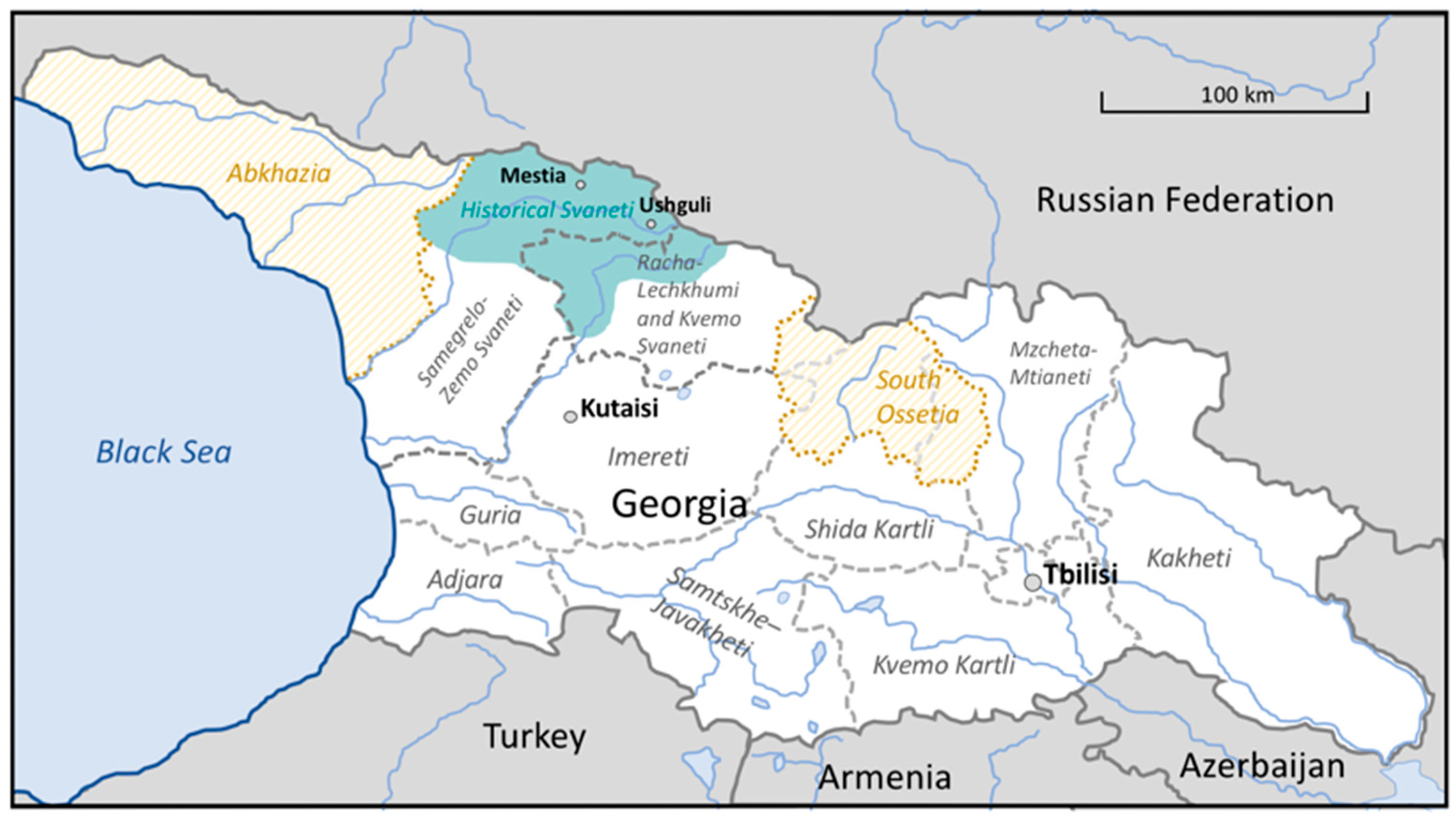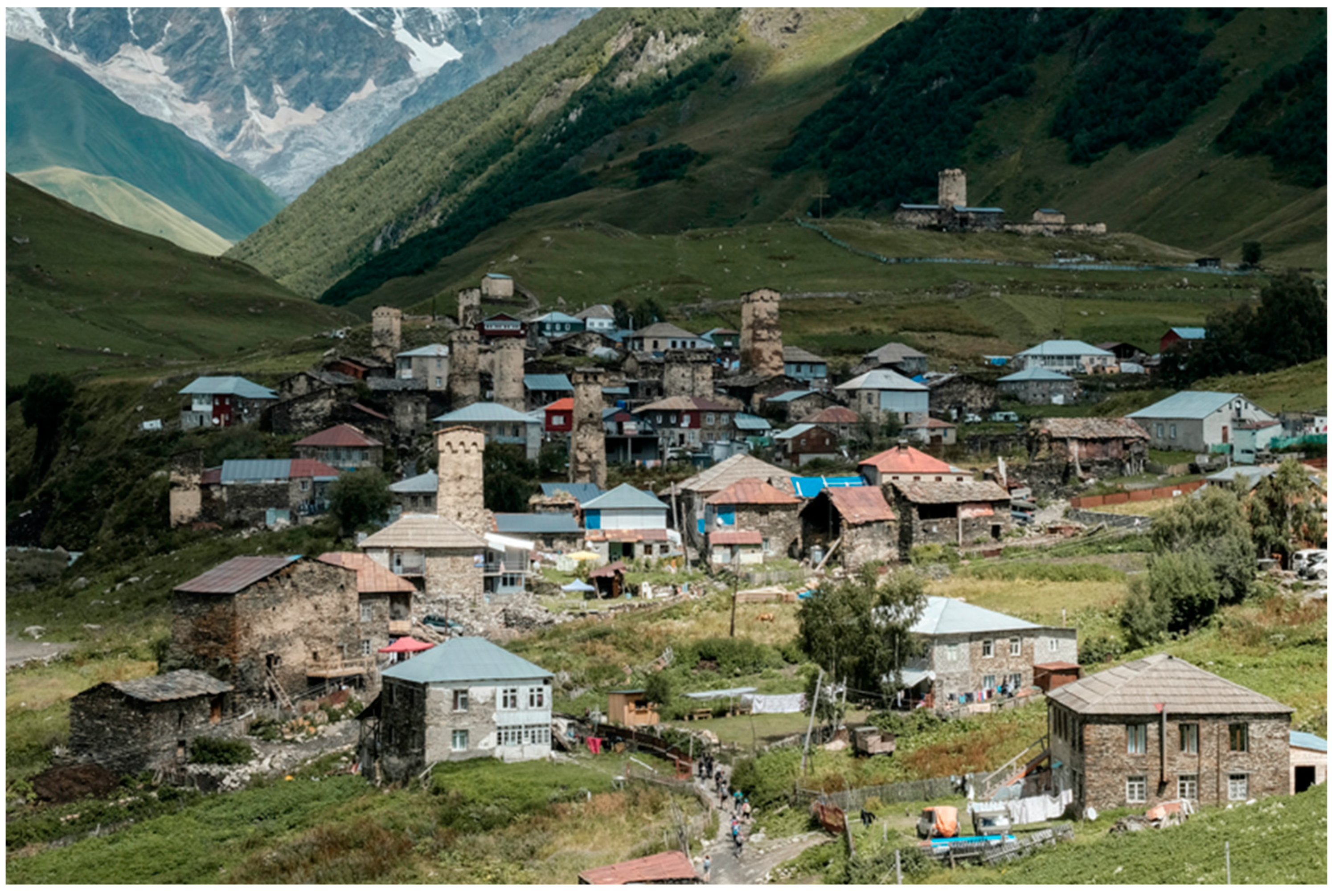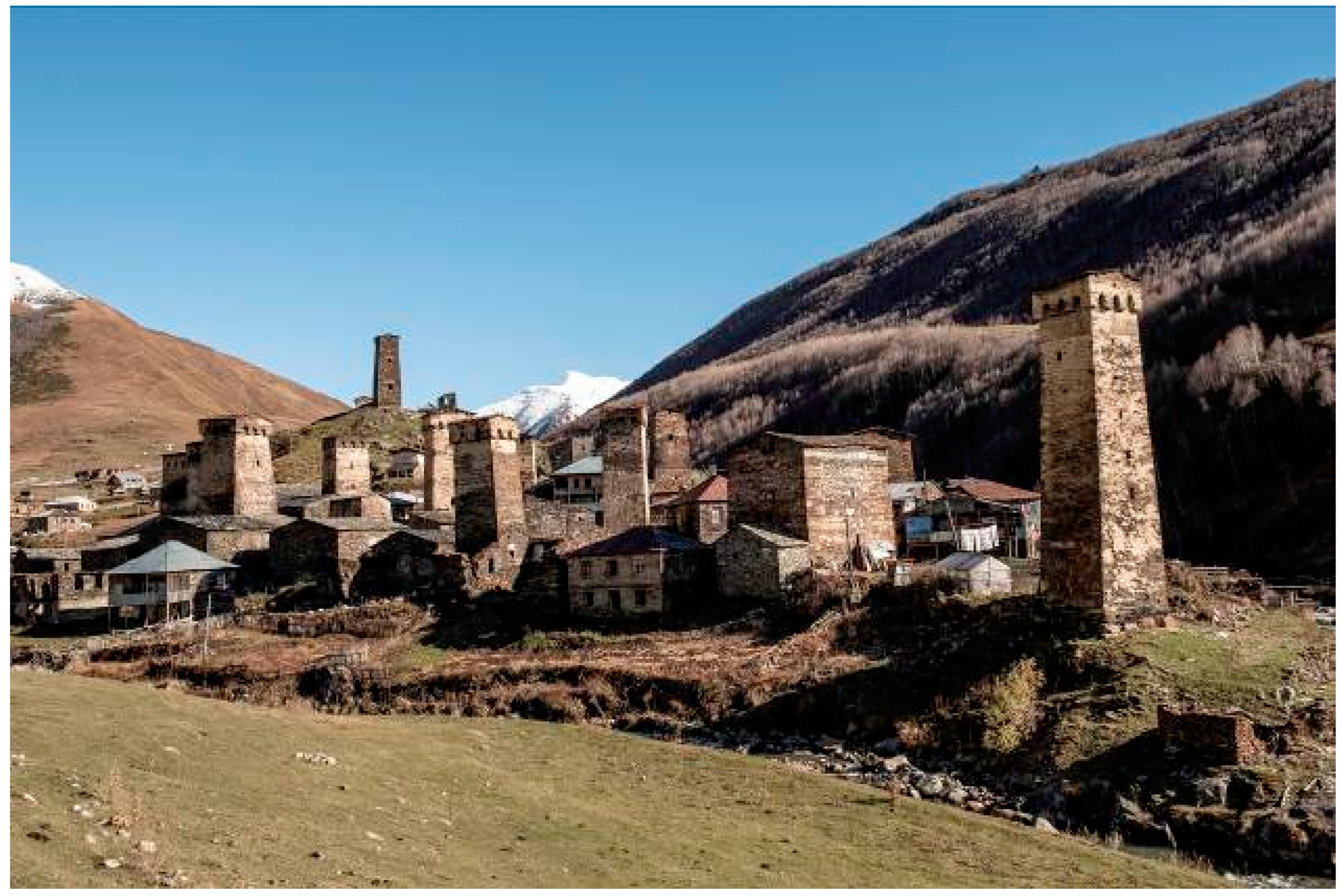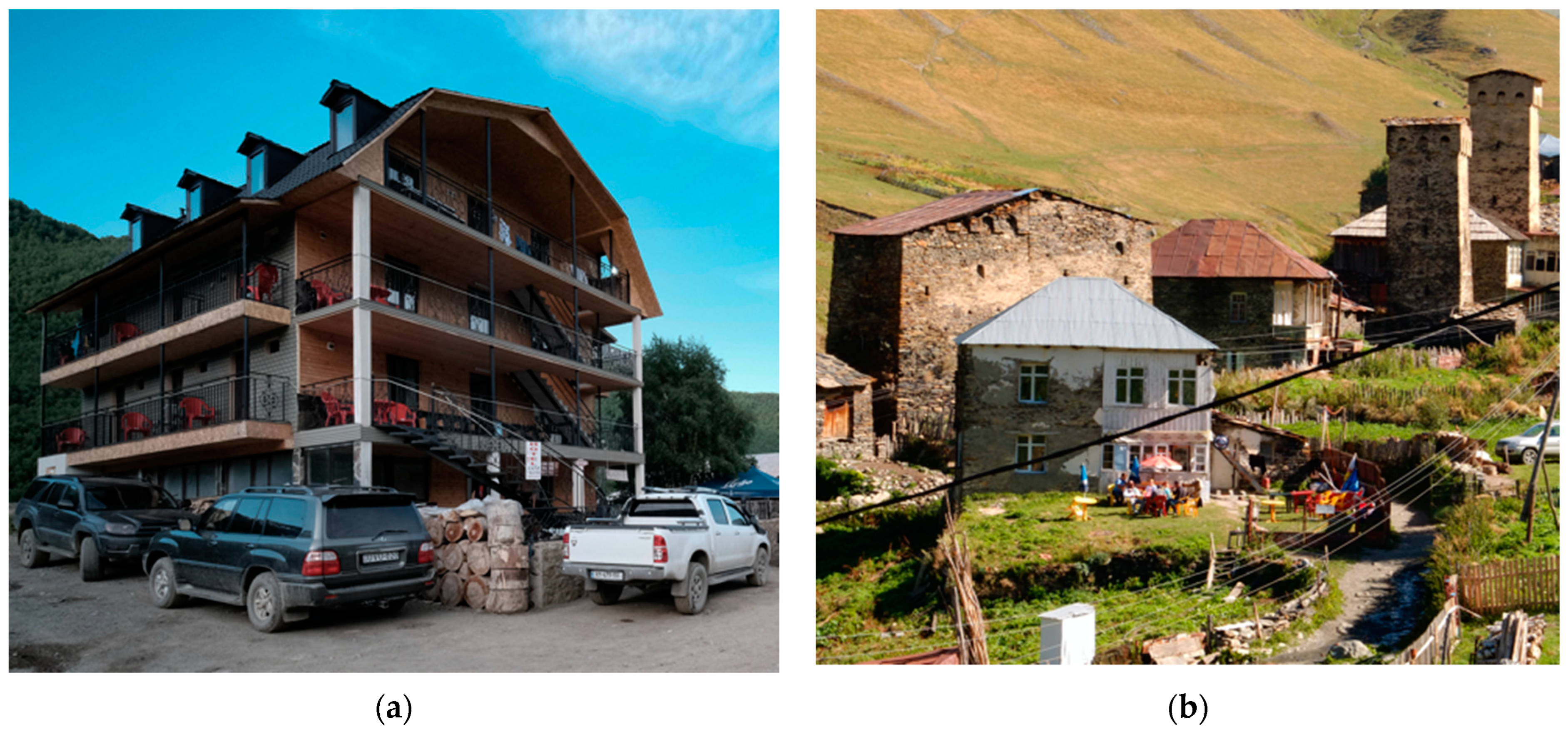You're using an outdated browser. Please upgrade to a modern browser for the best experience.

Submitted Successfully!
Thank you for your contribution! You can also upload a video entry or images related to this topic.
For video creation, please contact our Academic Video Service.
| Version | Summary | Created by | Modification | Content Size | Created at | Operation |
|---|---|---|---|---|---|---|
| 1 | Stefan Applis | -- | 2110 | 2022-05-13 09:00:06 | | | |
| 2 | Camila Xu | Meta information modification | 2110 | 2022-05-13 10:09:37 | | |
Video Upload Options
We provide professional Academic Video Service to translate complex research into visually appealing presentations. Would you like to try it?
Cite
If you have any further questions, please contact Encyclopedia Editorial Office.
Applis, S. Ushguli in Tourism (Svaneti, Georgia). Encyclopedia. Available online: https://encyclopedia.pub/entry/22904 (accessed on 14 December 2025).
Applis S. Ushguli in Tourism (Svaneti, Georgia). Encyclopedia. Available at: https://encyclopedia.pub/entry/22904. Accessed December 14, 2025.
Applis, Stefan. "Ushguli in Tourism (Svaneti, Georgia)" Encyclopedia, https://encyclopedia.pub/entry/22904 (accessed December 14, 2025).
Applis, S. (2022, May 13). Ushguli in Tourism (Svaneti, Georgia). In Encyclopedia. https://encyclopedia.pub/entry/22904
Applis, Stefan. "Ushguli in Tourism (Svaneti, Georgia)." Encyclopedia. Web. 13 May, 2022.
Copy Citation
The village community of Ushguli, located in the Upper Svaneti region in the North of Georgia, which attained UNESCO World Heritage status in 1996. Since around 2010, Ushguli has seen a step-by-step rise in tourism. Until now, it has found itself relatively unprepared to meet visitors’ interests and needs and cope with the diverse aspects of modern lifestyles.
Ushguli
Svaneti
Georgia
World Heritage
Caucasus
Heritage Tourism
1. Introduction
Georgia has a population of 3.7 million people, and up to 9 million international travelers visit the region each year [1]. The tourism industry makes up more than 10% of the country’s GDP, holds above 68% in service export and contributes about 30% in total to the country’s employment [2]. The international tourism industry regards Ushguli as an ideal Svan mountain village community. In Ushguli, one encounters a cultural area, where, as described in the UNESCO award, the medieval architecture combines with a uniquely impressive, authentic mountain landscape. All this has been preserved as the people still practice traditional mountain farming (Figure 1).
 Figure 1. Placement of the historical region of Svaneti in the recent political map of Georgia according to regions with the zones of the Abkhazian and South Ossetian conflict (Applis 2022).
Figure 1. Placement of the historical region of Svaneti in the recent political map of Georgia according to regions with the zones of the Abkhazian and South Ossetian conflict (Applis 2022).Located at the end of the Enguri gorge in Svaneti (Georgia), Ushguli initially represented a classic example of rural depopulation of a peripheral high mountain region. Beginning in the late 1980s, this community of four villages experienced a severe loss of population in the context of state-organized resettlement plans, prompted by a series of extreme weather events in 1986/87, including snowstorms and avalanches, which led to the outmigration of about 50% of the population [3][4][5]. In contrast to these events, strengths have emerged in recent years with the development of significant tourism potential. On the one hand, tourism provides families in the Upper Svaneti area with opportunities to overcome poverty and attain a degree of economic independence and, therefore, social security [6][7][8]. In remote mountain regions, rich cultural and ecological heritage can be found, and this is usually seen as a significant potential for tourism development [9][10][11][12]. In Ushguli, it seems that this promise may be at risk due to threats to the long-term survival of the cultural landscape.
2. Svaneti as a Special Cultural Area in Georgia
Ushguli’s value as a tourist destination lies in its defensive tower houses (see Figure 2) and the remarkably extensive retention of its landscape’s medieval-era appearance (Figure 3) [13][14][15]. The area has held UNESCO World Heritage status since 1996. The settlement Chazhashi (see Figure 3) is one of three places in Georgia to be listed as a World Heritage site. The UNESCO World Heritage List additionally names the whole of Upper Svaneti as an “exceptional” cultural landscape, but only Chazhashi holds the status itself.
 Figure 2. The upper villages of Ushguli with Mount Shkhara in the background (Applis 2019).
Figure 2. The upper villages of Ushguli with Mount Shkhara in the background (Applis 2019). Figure 3. View of Chazhashi, the current World Heritage site in Ushguli, which in the Soviet era was known as the Ushguli–Chazhashi Museum Reserve and has held protected status since 1971 (Applis 2018).
Figure 3. View of Chazhashi, the current World Heritage site in Ushguli, which in the Soviet era was known as the Ushguli–Chazhashi Museum Reserve and has held protected status since 1971 (Applis 2018).However, within the last years, uncoordinated building works in response to the tourist impact/influence on Ushguli have changed the community’s architectural character and the surrounding cultural landscape, producing discrepancies between UNESCO’s justification for awarding World Heritage status and the current situation in the region (Figure 4) [16][17]. It is possible that UNESCO could, as it has in other cases, diminish the geographical extent of Georgia’s World Heritage sites or remove the status from an entire architectural ensemble. In the meantime, this risk is also under discussion in Georgia [18][19]. Observers and the local population fear that a withdrawal of the World Heritage status could decrease the number of tourists and the chances of the mountain region catching up with its development [20][21].
 Figure 4. Different ways of constructing tourist space: (a) newly built hotel in European Alpine style (Applis 2019); (b) simple garden café in front of a 1950s Soviet-era building (Applis 2015).
Figure 4. Different ways of constructing tourist space: (a) newly built hotel in European Alpine style (Applis 2019); (b) simple garden café in front of a 1950s Soviet-era building (Applis 2015).Even in the Soviet era, Svaneti was known for the substantial ethnic homogeneity of its population and distinct conceptions of community and legal precepts, as is typical of some of the mountainous regions of the Caucasus [22][23][24]. This homogeneity derives from the population’s subsistence from agriculture at an altitude of 1500–2500 m and the resulting need for a collective lifeworld and long-term maintenance of strong identification with a shared origin and heritage. A concomitant issue is that the population has a clearly defined idea of their own identity and a distinct delimitation from neighboring groups [25].
From the early Soviet-era onwards, the region found itself the target of specific cultural interventions, typical for Soviet policy around nationality and national identities [26] (pp. 90ff.) about the relationship between the state and traditional law in Soviet times. However, Svaneti remained an exemplary region for limitations of measures that were intended to bring about cultural transformation. The Soviet authorities finally failed in their endeavors to break up local notions and institutions of law, such as councils of elders. Even in Soviet times, these councils intermediated in the arrangement of marriage, issues relating to the distribution of land and attempts to quell vendettas [22]. Even current studies suggest a continued high acceptance of such practices. They also indicate that non-Svan ethnic Georgians regard the country’s mountain people as possessing an authentic core of ethnonational “Georgianness”, inextricably linked to Georgian Orthodox Christianity [27].
3. General Challenges for Tourism Development in the Svaneti Region as Exemplified by the Village Community of Ushguli
There are numerous recent publications on Ushguli that have engaged with the region’s challenges. Most researchers emphasize the necessity of economically and socially sustainable approaches and highlight the risk to the location’s architectural heritage by human activity and natural events such as avalanches and land- and mudslides [28][29][30][31][32][33][34]. However, almost all these studies emerged from relatively brief stays by the relevant research groups, recording primarily quantitative data or collecting fairly straightforward qualitative material, such as short interviews. Consequently, they tend to focus on the general information of factors common to sustainable agritourism activities. However, there is an overall consensus that the specific social conditions that characterize Ushguli would prevent the success of any management plan imposed from outside. It would take years for stakeholders to gain awareness of the developments and shifts that ensue when numbers of tourists swell. Mosedalee [35] (p. 60) emphasized that “more in-depth research is necessary that analyses (a) the meanings of hospitality in a neoliberal political economy and changes to local cultures (in particular values of ‘giving’ hospitality), (b) the distinct entrepreneurial cultures emerging from new institutional and political-economic constellations and (c) the ‘new landscape of governance’, particularly as different actors and levels of scale become involved.”
Svaneti was more or less closed to researchers from parts of the world that were not part of the Soviet system until well into the 1990s. The region was also closed to tourists from Eastern Europe. Georgia’s accession to Europe and the USA after the civil war turmoil of the 1990s quickly opened Georgia to English-speaking researchers, as evidenced by the literature cited above. However, both Georgian and Russian as lingua franca are mostly not widely spoken by these researchers. Therefore, these studies rather test general theses on the development of peripheral regions using the example of Georgia’s mountain regions and present correspondingly general results.
However, Svaneti is a special case for various reasons explained in this research, which is why no meaningful qualitative data can be collected without appropriate language skills and without research designed for a longer period of time with long stays in the field. The qualitative data collected are accordingly not quantifiable. It is also questionable whether the social practices and phenomena described here are transferable to other peripheral regions on which several contributions are available (e.g., [36][37][38][39][40]). This is because traditionally shaped livelihoods unfold in culturally specific ways in the regions studied, where tourism is seen as a way of overcoming poverty. Comparing the available results would be a research goal in itself. This transfer cannot be undertaken here in a scientifically serious manner without visiting the corresponding regions.
Svaneti had only poorly developed mountaineering tourism during the Soviet era. This focused on the high peaks of the Great Caucasus and attracted mainly Soviet athletes. The Svans as an ethnic group thus had hardly any contact with tourists until well into the 2000s. During the Soviet period, Svaneti was considered a difficult region to control as explained above, despite intensive attempts to Sovietize it. The patriarchal structures of the communities there persisted, and collectivization was carried out only superficially. In fact, even Soviet law was only partially implemented there; de facto law continued to be pronounced in the communities by so-called councils of elders [22][26]. After the civil war in Georgia, Svaneti was a de facto lawless area for a long time; only in the early 2000s, the government there succeeded in defeating clan criminality and establishing security for the population.
The society of Svaneti has been confronted with multiple processes of globalization in the context of tourism development for about ten years now, of which the digitalization of travel in the form of online bookings and comments on stays is only one. Serious qualitative research in the mountain regions of Georgia must therefore overcome the following challenges: it must master linguistic thresholds and build long-term trust within fragile social communities in order to obtain reliable statements about the very specific challenges of the respective communities. Implementing these demands is the goal of the approach presented here. Therefore, in the following, reference is made to contributions by researchers from Georgia; the limitations of the older contributions to Svaneti, briefly outlined above, have been discussed elsewhere [16].
4. Effects of Over-Shaping the Livelihoods of Mountain Populations in Georgia
In recent years, Georgian researchers have pointed out that tourism in the previously relatively remote regions of the country also has adverse effects on social and economic livelihoods [2][28][41]. So far, only one study has been published that explicitly addressed the change in mountain livelihoods under the influence of tourism and examined the types of change. The researchers, like other researchers, set the preservation of the mountain farming cultural landscape as the norm. They used the examples of Mestia in Svaneti and Kazbegi in the Mtskheta-Mtianeti region to investigate why exactly tourism in the mountains of Georgia is causing a decline in agriculture. The researchers identified “4 types of tourism-led livelihood change: (1) expanding non-agricultural activities; (2) reducing agricultural activities; (3) developing agritourism activities and (4) increasing agricultural activities.” [42] (p. 27). Types 1 and 2 dominate and cause a massive decline in agricultural activities. This is because permanent residents of the mountain regions are too short of human, financial, technical and time resources to serve agriculture and tourism, and tourism work is less arduous. In contrast, the people who only stay in the region during the summer for the tourist season have less experience with agriculture and are more accustomed to urban lifestyles. In general, tourism causes intense competition between village communities because those who switch partly to accommodating guests soon depend on the income from overnight stays. Therefore, many researchers recommend integrating tourism and community development practices, developing specific guidelines for community-based tourism projects and filling the knowledge gap of community development facilitators on tourism practices [28][43][44]. In the case of the South Caucasus, the following definition of CBT is proposed: “CBT in the South Caucasus is a community development practice for nonurban and remote mountain villages. It is a joint effort of a group of people living in a certain geographical area, in which local culture, environment, and hospitality are the main advantages. CBT focuses on the benefits for the local people, capacity building, and empowerment and should constitute a core component of tourism activities in rural mountain regions” [44] (p. 20).
Great hopes for sustainable tourism are intimately connected with accommodation in permanently inhabited family houses, a kind of mixture of farm holidays and hiking as well as ecotourism. This is because the inhabitants who live in Ushguli all year round guarantee the preservation of the cultural landscape. Without them, there would be no horses, cows or pigs on-site, the pastures would not be mown, and there would not be the typical food that visitors can enjoy. The old stone buildings could hardly be preserved, and within a short time, there would be even more waste because the small farms would fall into disrepair, and no one would produce the food consumed locally ([19], p. 118, with reference to [17][21]).
If the hopes for development through tourism are to be fulfilled, especially in peripheral regions, strong and independent institutional support is needed for regional communities in which their own resources for regulating processes are not or no longer available. In Ushguli, the crisis experiences of the 1980s and 1990s can be considered the cause of the lack of these self-regulatory capacities.
References
- GNTA (2011–2020): Annual Report. Georgian Tourism in Figures. Georgian National Tourism Administration, Tbilisi. 2019. Available online: https://gnta.ge/statistics/ (accessed on 27 March 2022).
- Khelashvili, L.; Khartishvili, L.; Khokhobaia, M. Clustering the Problems of Sustainable Tourism Development in a Destination: Tsaghveri Resort as A Case. Ank. Üniv. Çevrebilimleri Derg. 2019, 7, 83–97.
- Stadelbauer, J. Hochgebirgstourismus in der Sowjetunion. Entwicklung, Formen und Problem am Beispiel des Großen Kaukasus. Erdkunde 1983, 37, 199–212.
- Stadelbauer, J. Gebirgskatastrophen und journalistische Transparenz in der Sowjetunion. Eine Interpretation der Schneefall-, Lawinen- und Überschwemmungskatastrophe des Jahres 1987 in Georgien. In Festschrift für Wendelin Klaer zum 65; Geburtstag Domrös, M., Ed.; Geographisches Institut der Universität Mainz: Mainz, Germany, 1990; pp. 257–278.
- Voell, S.; Jalabadze, N.; Janiashvili, L.; Kamm, E. Traditional Law as social Practice and cultural Narrative: Introduction. In Traditional Law in the Caucasus: Local Legal Practices in the Georgian Lowlands; Voell, S., Ed.; Curupira: Marburg, Germany, 2016; pp. 11–82.
- Gugushvili, A. Understanding Poverty in Georgia. Cauc. Anal. Dig. 2011, 34, 16–18.
- Echanove, J. The Feasibility of Adverting Collapse: The Resurgence of Georgia’s Agricultural Sector. Cauc. Anal. Dig. 2016, 88, 2–4.
- Pearce, K.E. Poverty in the South Caucasus. Cauc. Anal. Dig. 2011, 42, 2–12.
- Heiny, J. Socio-Economic Conditions of Rural Georgian Households and Their Behavioral Intentions Regarding Tourism Development: An Empirical Analysis; Justus-Liebig-University: Giessen, Germany, 2017.
- Gracheva, R.; Kohler, T.; Stadelbauer, J.; Meessen, H. Population dynamics, changes in land management, and the future of mountain areas in northern Caucasus: The example of North Ossetia. Erdkunde 2012, 66, 197–219.
- Arghutashvili, V.; Gogochuri, M. Characteristics of the long-term regional tourism development in Georgia. Int. Sch. Sci. Res. Innov. 2019, 13, 646–650.
- Putkaradze, M.; Abuselidze, G. The impact of tourism on business development in mountain regions: A case study. Int. J. Econ. Bus. Adm. 2019, 7, 70–83.
- ICOMOS. World Heritage List: Upper Svaneti. No 709: Advisory Body Evaluation. 1994. Available online: https://whc.unesco.org/en/list/709/documents/ (accessed on 27 March 2022).
- UNESCO. Convention Concerning the Protection of the World Cultural and Natural Heritage. World Heritage Committee. Twentieth Session Merida, Mexico, 2–7 December 1996. Available online: https://whc.unesco.org/archive/1996/whc-96-conf201-21e.pdf (accessed on 27 March 2022).
- Pavan, V. Svaneti Towers, Fortified Stone Villages in the Caucasus. In Glocal Stone. Verona Fiere—46th Marmomacc Fair. 2011. Available online: https://ambtbilisi.esteri.it/Ambasciata_Tbilisi/it/ambasciata/news/dall_ambasciata/special-issue-svaneti-towers.html (accessed on 27 March 2022).
- Applis, S. On the influence of mountain and heritage tourism in Georgia: The exemplary case of Ushguli. Erdkunde 2019, 73, 259–275.
- Applis, S. Tourism Sustains, and Threatens, Georgia’s Highland Heritage. Tales of an Authentic Society Living at the Edge of Time Fail to Account for Higher Living Standards in the Soviet Heyday. Eurasianet. 2 November 2018. Available online: https://eurasianet.org/perspectives-tourism-sustains-and-threatens-georgias-highland-heritage (accessed on 27 March 2022).
- Mountainstories (Ed.) Why Ushguli May Lose the World Heritage Status; Mountainstories: Tbilisi, Georgia, 2021; Available online: https://mountainstories.ge/news/item/1294-why-ushguli-may-lose-the-world-heritage-status (accessed on 27 March 2022).
- Tsintsabadze, N. Upper Svaneti World Heritage is in Danger. World Herit. Watch. Rep. 2021, 2021, 117–121. Available online: https://world-heritage-watch.org/content/wp-content/uploads/2021/06/WHW-Report-2021.pdf (accessed on 27 March 2022).
- Applis, S. World Heritage Tourism and the Built Space of Svaneti, Georgia. Peripheral Histories. 18 January 2021. Available online: https://www.peripheralhistories.co.uk/post/world-heritage-tourism-and-the-built-space-of-svaneti-georgia (accessed on 27 March 2022).
- Applis, S. The Threats to Georgia’s World Heritage Sites. Should Locals Be Expected to Forgo Modernity to Satisfy the Demands of UNESCO and the Global Tourism Industry? Eurasianet. 14 August 2020. Available online: https://eurasianet.org/perspectives-the-threats-to-georgias-world-heritage-sites (accessed on 27 March 2022).
- Köhler, J. Parallele und Integrierte Rechtsysteme in Einer Postsowjetischen Peripherie: Swanetien im Hohen Kaukasus 1999. Available online: https://www.academia.edu/11709536/Parallele_und_integrierte_Rechtssysteme_in_einer_postsowjetischen_Peripherie_Swanetien_im_Hohen_Kaukasus (accessed on 27 March 2022).
- Topchishvili, R. Svaneti and Its Inhabitants; National Parliamentary Library of Georgia: Tbilisi, Georgia, 2005; Available online: https://histinstitute.files.wordpress.com/2009/02/georgian_mountein_regions.pdf (accessed on 27 March 2022).
- Janiashvili, L. Traditional Law in Soviet Times. Cauc. Anal. Dig. 2012, 42, 5–7. Available online: https://css.ethz.ch/content/dam/ethz/special-interest/gess/cis/center-for-securities-studies/pdfs/CAD-42-5-7.pdf (accessed on 27 March 2022).
- Voell, S. Local Legal Conceptions in Svan Villages in the Lowlands. Cauc. Anal. Dig. 2012, 42, 2–4. Available online: https://css.ethz.ch/content/dam/ethz/special-interest/gess/cis/center-for-securities-studies/pdfs/CAD-42-2-5.pdf (accessed on 27 March 2022).
- Janiashvili, L. Traditional legal practice in Soviet times. In Traditional Law in the Caucasus: Local Legal Practices in the Georgian Lowlands; Voell, S., Ed.; Curupira: Marburg, Germany, 2016; pp. 83–124.
- Voell, S.; Jalabadze, N.; Janiashvili, L.; Kamm, E. Identity and traditional Law. Local Legal Conceptions in Svan Villages, Georgia. Anthropol. J. Eur. Cult. 2014, 23, 2.
- Khartishvili, L.; Muhar, A.; Dax, T.; Khelashvili, I. Rural Tourism in Georgia in Transition: Challenges for Regional Sustainability. Sustainability 2019, 11, 410.
- Voll, F.; Mosedalee, J. Political-Economic Transition in Georgia and its implications for tourism in Svaneti. TIMS Acta 2015, 2, 91–103.
- Engel, E.; von der Behrens, H.; Frieden, D.; Möhring, K.; Schaaff, C.; Tepper, P.; Müller, U.; Prakash, S. Strategic Options towards Sustainable Development in Mountainous Regions. A case Study on Zemo Svaneti, Georgia; SLE Publication Series; Faculty of Agriculture and Horticulture: Berlin, Germany, 2006; Available online: https://edoc.hu-berlin.de/bitstream/handle/18452/3820/224.pdf?sequence=1 (accessed on 27 March 2022).
- Alternative, G. (Ed.) Problems Related to the Protection of Property Rights—The Case of Mestia. Report within the Framework of the Project “Protection of Property Rights in New Touristic Zones of Georgia”. 2011. Available online: http://www.crystalfund.ge/wp-content/uploads/Report_Mestia_ENG_July_2011_.pdf (accessed on 27 March 2022).
- Tarragüel, A.; Krol, B.; van Westen, C.J. Analyzing the possible impact of landslides and avalanches on cultural heritage in Upper Svaneti, Georgia. J. Cult. Herit. 2012, 13, 453–461.
- Tarragüel, A. Developing an Approach for Analyzing the Possible Impact of Natural Hazards on Cultural Heritage: A Case Study in the Upper Svaneti Region of Georgia. Master’s Thesis, University of Twente, Faculty of Geo-Information Science and Earth Observation, Enschede, The Netherlands, 2011; pp. 87–92. Available online: https://webapps.itc.utwente.nl/librarywww/papers_2011/msc/gem/tarraguel.pdf (accessed on 27 March 2022).
- Cappucci, M.; Zarrilli, L. New trends in mountain and heritage tourism: The case of Upper Svaneti in the context of Georgian tourist sector. Geoj. Tour. Geosites 2015, 15, 65–78. Available online: https://www.researchgate.net/publication/282220363_New_trends_in_mountain_and_heritage_tourism_The_case_of_upper_svaneti_in_the_context_of_georgian_tourist_sector (accessed on 27 March 2022).
- Mosedalee, J. Political Economy of Tourism: Regulation Theory, Institutions and Governance Networks. In The Wiley-Blackwell Companion to Tourism; Hall, C.M., Lew, A.A., Williams, A.M., Eds.; John Wiley and Sons, Ltd.: Oxford, UK, 2014; pp. 55–65.
- Anup, K.C.; Thapa Parajuli, R. Tourism and its impact on livelihood in Manaslu conservation area, Nepal. Environ. Dev. Sustain. 2014, 16, 1053–1063.
- Chen, B.; Qiu, Z.; Usio, N.; Nakamura, K. Tourism’s Impacts on Rural Livelihood in the Sustainability of an Aging Community in Japan. Sustainability 2018, 10, 2896.
- Munanura, I.E.; Sabuhoro, E.; Hunt, C.A.; Ayorekire, J. Livelihoods and Tourism: Capital Assets, Household Resiliency, and Subjective Wellbeing. Tour. Hosp. 2021, 2, 347–364.
- Aduabuchi Ijeomah, H.M. Impact of tourism on livelihood of communities adjoining. Ijomah/Cult.—Rev. Cult. E Tour. 2012, 3, 55–71.
- Zuo, Y.; Law, R.; Zhang, M. Impact of farmers’ participation in tourism on sustainable livelihood outcomes in border tourism areas. Int. Sociol. 2021, 33, 50–77.
- Somuncu, M. The Caucasus Regional Research Agenda 2020–2030; Scientific Network for the Caucasus Mountain Region of Georgia: Tbilisi, Georgia, 2019.
- Salukvadze, G.; Backhaus, N. Is Tourism the Beginning or the End? Livelihoods of Georgian Mountain People at Stake. Int. Mt. Soc. 2020, 40, 28–36.
- Khartishvili, L.; Mitrofanenko, T.; Penker, M. Issues with Applying the Concept of Community-Based Tourism in the Caucasus. Mt. Res. Dev. 2020, 40, 11–20.
- Reid, D.G.; Mair, H.; George, W. Community tourism planning: A self-assessment instrument. Ann. Tour. Res. 2004, 31, 623–639.
More
Information
Subjects:
Geography
Contributor
MDPI registered users' name will be linked to their SciProfiles pages. To register with us, please refer to https://encyclopedia.pub/register
:
View Times:
2.9K
Revisions:
2 times
(View History)
Update Date:
13 May 2022
Notice
You are not a member of the advisory board for this topic. If you want to update advisory board member profile, please contact office@encyclopedia.pub.
OK
Confirm
Only members of the Encyclopedia advisory board for this topic are allowed to note entries. Would you like to become an advisory board member of the Encyclopedia?
Yes
No
${ textCharacter }/${ maxCharacter }
Submit
Cancel
Back
Comments
${ item }
|
More
No more~
There is no comment~
${ textCharacter }/${ maxCharacter }
Submit
Cancel
${ selectedItem.replyTextCharacter }/${ selectedItem.replyMaxCharacter }
Submit
Cancel
Confirm
Are you sure to Delete?
Yes
No




